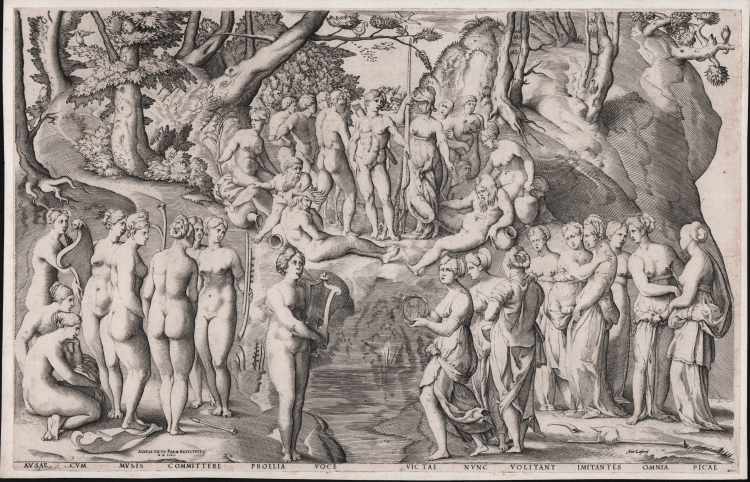




| Reference: | S36042 |
| Author | Gian Jacopo CARAGLIO |
| Year: | 1553 |
| Measures: | 384 x 295 mm |



| Reference: | S36042 |
| Author | Gian Jacopo CARAGLIO |
| Year: | 1553 |
| Measures: | 384 x 295 mm |
Engraving, 1553, lettered in the margin: 'AVSAE CVM MVSIS COMMITERE PROETIA VOCE VICTAE NVNC VOLITANT IMMITANTES OMNIA PICAE', signed and dated lower left: 'AENEAS VICVS PARM RESTITVIT/MDLIII', and inscribed with publisher's address lower right: 'Ant. Lafrerij exc.'
Example of sixth state of six.
A very good proof printed on contemporary laid paper with watermark “triple mount in shield with crown”, trimmed close to platemark, very good condition.
Giorgio Vasari mentioned this print as Jacopo Caraglio's third work engraved in Rome after Rosso Fiorentino's design (Lives, vol. 5, pp. 424-25). While no drawing for the print survived, Carroll in Washington 1987 retained the Rosso attribution and suggested the composition was inspired by Raphael's early drawings for the Parnassus, probably known to Rosso through Marcantonio Raimondi's engraving (Bartsch XIV.200.247).
However, the image is also related to Rosso's late Florentine works, as well as to antique statues. The inscription of Caraglio's print refers to a story in Ovid's Metamorphoses (V, 294-678).
The worn-out plate was completely reworked by Enea Vico, see TIB 2808.053.S5 [TIB 30, B.28 (295)]
|
Bartsch XV.295.28 (Jacopo Caraglio's print reworked by Enea Vico, second state of two); Bartsch XV.89.53 (Jacopo Caraglio's print reworked by Enea Vico); Cirillo Archer in TIB 1995, 2802.053.S6 (sixth state of six); Barryte, n. 221, p. 624.
|
Gian Jacopo CARAGLIO (Verona 1505 - Cracovia 1565)
|
Giovanni Jacopo Caraglio or Caralio, Caral, Caralius, was a copper engraver, gem cutter, goldsmith and maybe even architect, according to Vasari. Caraglio was born approximately in 1505, in Verona or Parma, that is the reason why he often refers to himself as Veronensis or Parmensis. Because of the Sack of Rome he was obliged to leave unfinished his Ratto delle Sabine (The Rape of the Sabine Women), after a drawing of Rosso Fiorentino. He moved to Venice, were he worked until 1537.
While in Rome, he worked for Baviera, realizing in 1562 Dei dell’Olimpo, Fatiche di Ercole and Amori degli Dei, all after Rosso’s drawings, his favourite artist, together with Baldinelli and Parmigianino. While in Venice, on the contrary, he worked on subjects from Titian.
He moved to Poland in 1539 and started spreading the graphic art of Marcantonio in the Eastern Countries.
On July the 3rd, 1545, he joined the Court of Siegmund II, with an annual salary of 60 florins, till the death of the King in 1548; he afterwards worked for King Siegmund II Augustus as goldsmith and gem cutter. In 1552 he’s said to be working in Vilna, in Lithuania, the second capital city of the kingdom where the Court had temporarily moved. He went back and forth from Italy to Lithuania untill he died, on August the 26th, 1565.
Bartsch has listed 65 engravings belonging to Caraglio; Le Blanc has added other four subjects.
|
|
Bartsch XV.295.28 (Jacopo Caraglio's print reworked by Enea Vico, second state of two); Bartsch XV.89.53 (Jacopo Caraglio's print reworked by Enea Vico); Cirillo Archer in TIB 1995, 2802.053.S6 (sixth state of six); Barryte, n. 221, p. 624.
|
Gian Jacopo CARAGLIO (Verona 1505 - Cracovia 1565)
|
Giovanni Jacopo Caraglio or Caralio, Caral, Caralius, was a copper engraver, gem cutter, goldsmith and maybe even architect, according to Vasari. Caraglio was born approximately in 1505, in Verona or Parma, that is the reason why he often refers to himself as Veronensis or Parmensis. Because of the Sack of Rome he was obliged to leave unfinished his Ratto delle Sabine (The Rape of the Sabine Women), after a drawing of Rosso Fiorentino. He moved to Venice, were he worked until 1537.
While in Rome, he worked for Baviera, realizing in 1562 Dei dell’Olimpo, Fatiche di Ercole and Amori degli Dei, all after Rosso’s drawings, his favourite artist, together with Baldinelli and Parmigianino. While in Venice, on the contrary, he worked on subjects from Titian.
He moved to Poland in 1539 and started spreading the graphic art of Marcantonio in the Eastern Countries.
On July the 3rd, 1545, he joined the Court of Siegmund II, with an annual salary of 60 florins, till the death of the King in 1548; he afterwards worked for King Siegmund II Augustus as goldsmith and gem cutter. In 1552 he’s said to be working in Vilna, in Lithuania, the second capital city of the kingdom where the Court had temporarily moved. He went back and forth from Italy to Lithuania untill he died, on August the 26th, 1565.
Bartsch has listed 65 engravings belonging to Caraglio; Le Blanc has added other four subjects.
|